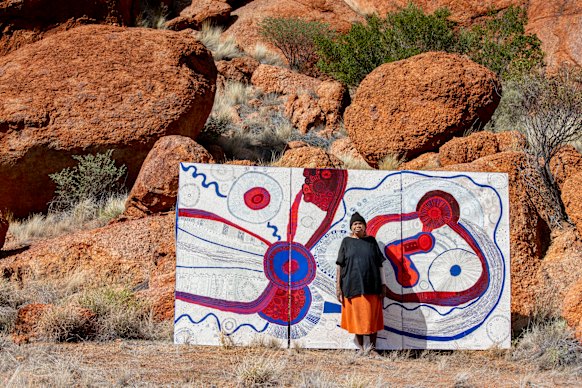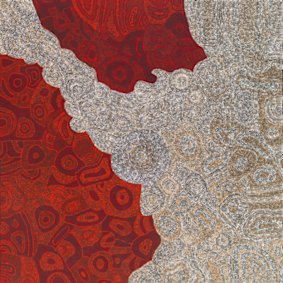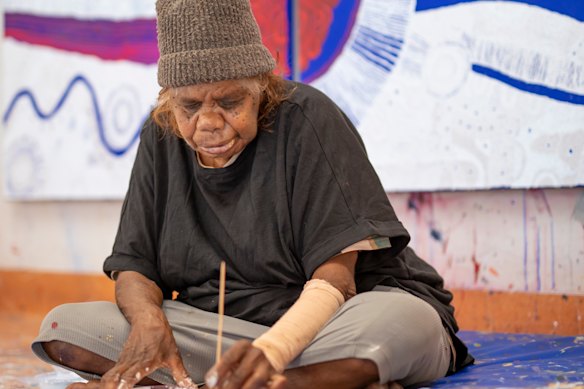Landmark show is a monumental tribute to family, Country and care
By Ksenia Radchenko
The Bundanon Art Museum’s Winter Series opens with a landmark exhibition by Betty Kuntiwa Pumani, one of the most celebrated painters from the Anangu Pitjantjatjara Yankunytjatjara (APY) Lands. A senior cultural custodian and long-time artist with Mimili Maku Arts, she paints in the community where she lives, grounding her work in the rhythms of Country. Her practice rests on a powerful matrilineal line, shaped by generations of women who have carried and shared cultural knowledge through image, story and ceremony.
Small in number but monumental in scale, the paintings in this show trace Pumani’s artistic evolution over more than 15 years. Together, they chart a compelling arc, honouring both the refinement of her style and the deep knowledge that sustains it. While her visual language shifts over time, her subject stays constant: her Country, Antara – held, reimagined and passed down through generations.

Betty Kuntiwa Pumani with her major work, Antara, commissioned for Malatja-malatja at Bundanon, 2025.Credit: Courtesy the artist and Mimili Maku Arts.
Curated by Bundanon chief executive Rachel Kent, in collaboration with Mimili Maku Arts, the exhibition centres on Pumani’s intergenerational matrilineage. Her first major museum survey honours the women who shaped her practice and those who will carry it forward. Its title, Malatja-malatja – a Pitjantjatjara phrase meaning “those who come after” – speaks to a responsibility grounded, not in ownership, but in care and continuity. What we do now, Pumani reminds us, belongs to the generations ahead.
This vision of custodianship runs through her work and is echoed in the presence of key paintings by her mother, Kunmanara (Milatjari) Pumani, and elder sister, Kunmanara (Ngupulya) Pumani. Their works root the exhibition in shared authority and matrilineal knowledge. These mesmerising, pulsating canvases reveal how ancestral stories adapt over time. The story stays the same, but each artist brings it to life through her own visual language. In Pumani’s hands, that language is unmistakable: cobalt waterholes, Pilbara-red boulders, and white, lace-like passages that conjure maku and tobacco flowers. Her paintings carry Country’s pulse, its lifeblood flowing through red veins and deep blue springs, surrounded by the quiet shimmer of renewal.
Intergenerational continuity finds vivid expression in Antara (2020), a collaborative work painted with her daughter, Marina Pumani Brown. Here, Betty’s signature red and blue dissolve into a glowing orange against deep black – an elemental transformation that speaks to the shifting palette of Country and the enduring power of kinship. By linking her ancestral past with the generations to come, Pumani grounds her practice in care for Country and family.
“I’m thrilled to see my older paintings and my newer paintings together,” Pumani said at a preview tour earlier this month. “For this exhibition, I painted one more canvas for the next generation. I was thinking about the women who came before me, and those who will come after me. This is for future generations, for those children to learn from.”

Betty Kuntiwa Pumani, Antara 2012.Credit: Courtesy of the artist and Mimili Maku Art
One of the exhibition’s revelations is Antara (2013), an early painting in an unexpected mix of bright orange and green that evokes the seasonal shifts of Country. This bold palette softens in another rarely seen painting from the same year, where lemony yellow appears – echoing, as Kent notes, the clay found in the women’s rockholes of Antara. Pumani recalls how her mother would rub that ochre on their skin and sing songs to summon witchetty grubs – the yellow pigment recalling the grubs themselves.
By 2014, while the cobalt waterholes that define her later work are still emerging, the dense red and burgundy boulders that mark the sacred hills shaped like maku appear more strongly, refining her vision of Country’s topography. These early works are on loan from the newly-formed Mimili Maku Arts Cultural Collection, an initiative that keeps significant paintings on Country where family, community and future custodians can access them.
Pumani’s commitment to future generations is more than symbolic – it’s practical and material. Mimili Maku joins other First Nations art centres asserting cultural self-determination through community-led collecting. In northeast Arnhem Land, Yirrkala began building its cultural collection decades ago, ensuring foundational works remain in community. These collections aren’t just archives but living repositories.

Betty Kuntiwa Pumani in her studio at Mimili Maku Arts.Credit: Courtesy the artist and Mimili Maku Arts
Two short films in the show make this philosophy tangible. We see Pumani walking across the rocky terrain of Antara, her paintings Antara (2020) and the newly commissioned Antara (2025) resting on the red earth beside her. Before a painting can travel, it must return to Country, absorbing its spirit and reaffirming its origin. This is more than symbolic – the paintings are treated not as objects but as kin.
In Bundanon’s airy, minimalist galleries, each canvas holds its own quiet force, inviting visitors to slow down and truly look. Pumani’s steady voice drifts through the space. She speaks of Antara, and the viewer is drawn into a place where image, memory and presence converge. To stand before them is to feel the ground shift slightly, as if something ancient has stirred. At Bundanon – Arthur Boyd’s “deep valley,” where art and land are inseparable – Pumani’s Antara feels intuitively at home, resonating with a place shaped by time, ecology and care. If Boyd imagined land belonging to its people, Pumani paints the ceremonies that keep that belonging alive.
Unlike other works here, her new Antara (2025) triptych glows with ever-brighter passages of white, as if calling maku and tobacco flowers back to life, despite warming ground and dwindling rain — turning paint into ceremony and pigment into an ecological record. In every gesture, Pumani shows that caring for our families, stories and everyday places is how we care for the whole. Her message is quiet but powerful: the future doesn’t live somewhere else. It begins here, with the rocks, the grubs, the flowers – and the children who will inherit them. Change begins with looking after what is already ours.
Betty Kuntiwa Pumani: Malatja-malatja (those who come after) is at Bundanon Art Museum until October 5. The artist will present a talk at the gallery on September 20.
Ksenia Radchenko is an art historian and curator. The writer was a guest of the gallery.